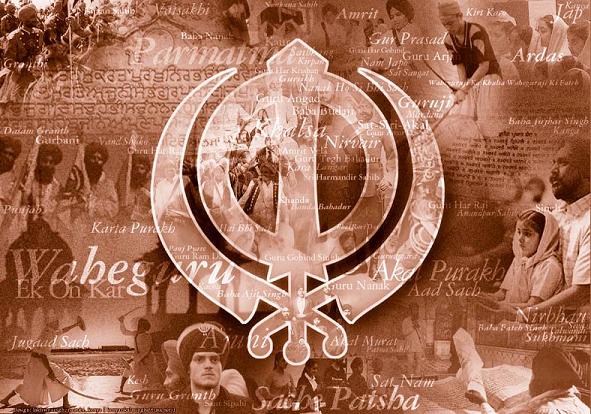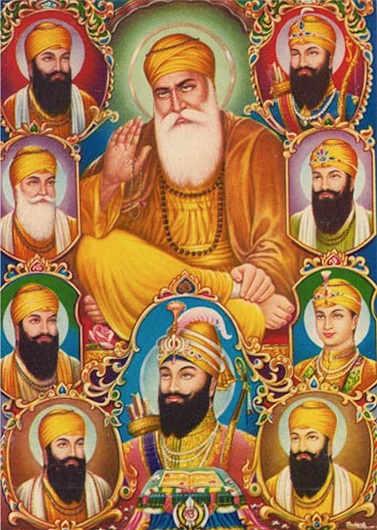Guru Nanak Dev, born in 1469, was a religious and social revolutionary. He protested against the injustice done to the people by both the political rulers and the religious authorities of the time.
The ruling community, the Muslims, came from the Middle East. Being all powerful, they considered themselves superior human beings and denied social rights to their Hindu subjects. They wanted the Hindus to become Muslims and used force to achieve this aim. They often tortured them and even killed them for refusing to give up their faith. Brahmans, the priestly class, also sucked the blood of the poor Hindu masses. They had the sole right to perform social and religious functions and therefore were able to extract forced donations from them. To refuse the helpless people their social and religious rights, the Brahmans cooperated with the ruling Muslims. About a fifth of the local Indian people were degraded as low-caste, untouchables and treated even worse than animals.
Because of these pressures, many Hindus became Muslims. Low caste people adopted Islam to wash the stigma of being considered low grade human beings.
The Brahmans assumed the status of the highest class. According to them, the Khatris, the fighting class, were next, while the working majority, Vaish, farmers and traders, were given the third rank in society. Women were considered "incomplete" and "unclean" persons and were not entitled to the same status as men.
To educate people regarding their human rights and Sikh philosophy, Guru Nanak founded the institutions of sangat and pangat, where all people would sit together as equals without any kind of discrimination on the basis of birth, worth, sex, creed, color, etc. When they joined together to sing praises of the Lord, their congregation was called sangat and when they sat together to eat langar, they were called pangat. To obtain solace, all people, Hindus and Muslims irrespective of their caste, flocked to join sangat and pangat. The idea of providing equal rights to all human beings was a revolutionary concept.
This organized movement, which rejected the oppression of the people through political, social or religious authority, was not to the liking of the rulers or the Hindu religious leaders. They wanted to destroy this movement and for that purpose they adopted all possible means within their power. The Gurus fearlessly continued to preach against the social and religious evils and protested against the repressive policy of the state. When the state adopted violent methods to finish this movement of religious and human rights, the Sikhs were forced to defend themselves with the sword.
Guru Amar Das was charged with defiling the Hindu faith because he permitted everyone including the untouchables to take water from the same baoli (open well with steps reaching the water level) and letting everyone sit together as equals in the pangat. The Guru was summoned to the court. Akbar, then emperor of Delhi, listened to both sides and rejected the memorandum of the people who complained against the Guru. Later, during the rule of Jehangir who had decided to check the wave of Sikhism, Guru Arjan Dev was arrested, taken to Lahore, and tortured to death in 1606. Instead of being demoralized or terrorized because of this violence as intended by the rulers, the Sikhs exhibited great bravery and fearlessness. They repulsed all four attacks of the Emperor's army during the life of Guru Har Gobind, the son of Guru Arjan Dev.
The harassment of the Gurus continued far into the seventeenth and eighteenth centuries. Guru Teg Bahadur, the ninth Guru and his three associates Bhai Mati Das, Bhai Sati Das, and Bhai Dyala were tortured and brutally killed. Guru Gobind Singh was also attacked many times and forced to leave Anandpur, of course, after being assured of peace. Breaking their oaths, the joint army of the Hindu rajas and the Emperor of Delhi attacked the Sikhs when they were out of the fort. Thousands of Sikhs and all four sons of the Guru were killed. The older two gave their lives at Chamkaur defending religious freedom and human rights, while the younger two were murdered by the Nawab of Sirhind. The Sikhs defeated the Imperial army at Mukatsar in the last battle after which the Guru established a new Sikh center at Talwandi, District Bhatinda. The Gurdwara there is now known as Takhat Damdama Sahib.
After the death of Guru Gobind Singh in 1708 at Nanded, Maharashtra, the Sikhs continued their struggle against state repression, first, under the guidance of Baba Gurbakhsh Singh, popular as Banda Singh Bahadur, up to 1716 and then under other Sikh leaders chosen after his death. The people finally obtained full freedom from all kinds of state and religious terrorism. Hindus and Muslims jointly ruled Punjab under the leadership of Maharaja Ranjit Singh.
The sakhis of some Sikh martyrs of this period are mentioned here to tell how bravely they faced state terrorism, and shed their blood to protect religious freedom and human rights.
- Martyrdom of Ajit Singh and Jujhar Singh
- Martyrdom of Zorawar Singh and Fateh Singh
- Kaka Hakikat Rai
- Banda Singh Bahadur
- Subeg Singh and Shahbaj Singh
- Bhai Mani Singh
- Garja Singh and Bota Singh
- Sukha Singh and Mehtab Singh
- Bhai Taru Singh
- Mai Bhag Kaur
- Shaheed Ganj, Lahore
- Sardarni Sada Kaur
- Sardarni Sharnagat Kaur
- Mata Kishan Kaur Kaonke

